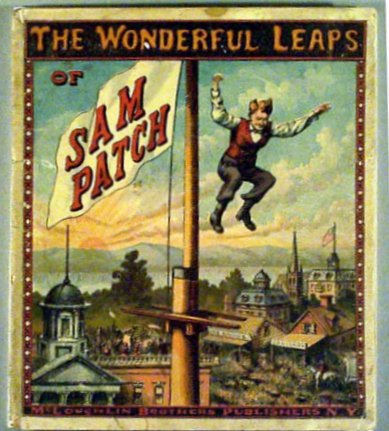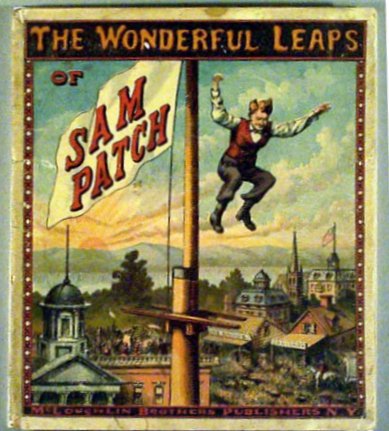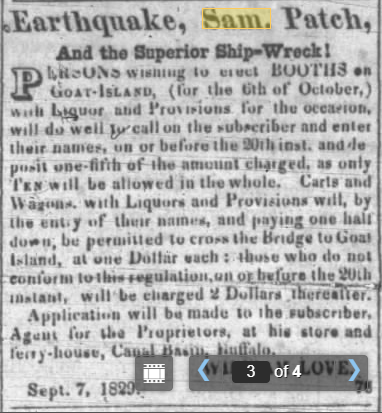
We live in the era of extreme sports and it seems there are plenty of daredevils who push right on past the boundaries of good sense, sometimes to their peril. But did you know that the 20th and 21st centuries don’t have the corner on risk-takers? A young man who became a legend for his jumping exploits rose to a meteoric fame and in the same fashion ended his career in 1829 at the Genesee River.
Sam Patch was born around 1799 in South Reading, Massachusetts. His father, Greenleaf Patch was a farmer. Besides Sam, the Patches had two other sons and two daughters. Sam’s father died when he was a young boy, and his mother moved the family to Pawtucket, Rhode Island. It was there Sam found employment in the cotton mills to help support the family. Many boys of his young age worked in the cotton spinning mills, leaving schooling for others. A favorite pastime after work was swimming in the river near the mills, and the boys took every opportunity to enjoy the water. The bridge that spanned the deep Blackstone River seemed to beg for someone to jump from it into the water below. Sam was quick to take on the dare to plunge from the top rail of the bridge into the river. He was immediately successful and soon began looking for higher places to leap from. Several of his friends along with some men decided that jumping from one of the mill roofs into the river would be their next conquest. For whatever reason, jumping was a popular entertainment at the time. The mill roofs provided a drop of 100 feet, and surprisingly the entire crew jumped safely from the great height. Eventually the glow of jumping wore off when no new challenges presented themselves.
Despite his dangerous hobby, Sam escaped injury, grew up and went into business with a mill owner for a period of time in Pawtucket. However, his partner whose last name was Kennedy wasn’t an honest fellow and helped himself to the profits before leaving town. Now in dire financial straits, Sam had to change his plans. He sold the mill to pay off the accumulated debts and left for Patterson, New Jersey to try his luck in another mill. It was there he regaled his new friends with tales of his jumping into the Blackstone. Not convinced that Sam was such a talented leaper, he had to prove himself, jumping from a bridge into the Passaic River. This led to more jumps and soon Sam found himself on a new career path as a daredevil entertainer who could command a nice admission price. In 1827 he jumped from bowsprits and yardarms of ships, drawing large crowds. In no time he’d become a celebrity and took to it like a duck to water (pun intended). Sam was a talented self-promoter, always on the prowl for new venues to exhibit his jumping prowess.
In 1829, he was invited to Niagara Falls to participate in a magnificent patriotic event scheduled for October 6. A dangerous rock shelving was to be blasted away to improve the safety of tourists admiring the falls. An old ship was also going to be sent plunging over the falls for a spectacular wreck at the bottom the chasm, and the promoters hoped Sam would jump the falls, providing a full day of entertainment. Sam agreed, although the thought of playing second fiddle to an explosion and shipwreck didn’t sit well with him. The event was widely publicized with vendors vying for space to sell liquor and other provisions for the crowd. Canadians and Americans were anxious to witness the extravaganza.
The more Sam thought about sharing the day with two other exhibitions, the more reluctant he became. In true celebrity style, he arrived too late on the 6th to perform, but he promised the throng he would jump the following day. Eager spectators gathered on October 7th to watch Sam climb a 40-foot ladder on Goat Island to a platform for jump of 85 feet. Dressed in white, his arms stiff at his sides, Sam leapt from the platform, dropping like an arrow into the churning Niagara. Boats waited below to rescue him, and most expected it to be a recovery mission. No one could survive such a jump—or so they thought. While the sailors searched the foaming waters for a body, Sam was already on the shore singing merrily, waving to the crowds. Sensing that there was more money to be made from the citizens on both sides of the river, he immediately promised another jump on October 17. This he also did successfully much to the delight of his fans. At some point during his visit to Buffalo, he purchased a pet bear, deciding that the animal would be an asset to the act. Sam decided he would leap first and then the bear would jump (that is be pushed off a platform by his owner) to keep the interest of the people.
Folks in Rochester heard about Sam’s incredible feats and invited him to jump the Genesee Falls (the High Falls) to spice up the entertainment realm there. Sam welcomed the challenge, and on November 6, 1829 before a crowd of an estimated 10,000, Sam took the plunge, quickly finding the shore amid thunderous applause. It was now the bear’s turn, and Sam coaxed the bear to the platform, unceremoniously pushing him into the water. Fortunately, the animal was unfazed, easily swimming to shore unharmed.
Once again, Mr. Patch saw an opportunity for some more coin in his pocket and scheduled another jump, advertised as his last for November 13th. He wanted this last jump in Rochester to be more spectacular and so the platform height was increased another 25 feet, making the leap around 125 feet to the water below. Sam needed to build his resume as he wished to jump from London Bridge. Crowds swelled for the big day as Sam took a slug of brandy before climbing to the platform. Dressed in his usual white clothing he greeted the onlookers, assumed his straight-arrow posture, jumping from the wooden structure. A spectator wrote this description:
The staging was elevated twenty-five feet—He sprung fearlessly from it and descended about one-third of the distance as handsomely as he ever did. He then began evidently to droop, his arms were extended; his legs separated; and in this condition he struck the water and sunk forever! It was a fearful leap and fearfully it has terminated. The prevailing opinion is he became lifeless ere he reached the water.
As the horrified masses watched and waited, Sam didn’t reappear. After a few minutes, they left the river. Entertainment had turned into tragedy before their eyes. While searchers looked desperately for the body, newspapers began reporting the sad results. Without concrete evidence of Patch’s death though, rumors abounded throughout the winter that he was still alive and was “sighted” in different cities over the next few months. Some were convinced it had all been a publicity stunt. However, in March 1830, his body was discovered in the ice at the mouth of the Genesee River. Although the remains weren’t exactly identifiable, the clothing was, including the black sash that he tied around his waist for performances. Now certain of the body’s identity, Sam was buried in an unmarked grave in the Charlotte Cemetery, near where he was found. It wouldn’t be until the mid-twentieth century that a group of students raised money to place a stone on the grave.
Sam Patch was immortalized in children’s books, poetry, and in song for his daring feats as America’s first professional daredevil throughout the 19th century. Although his career was incredibly short, his exploits have lived on for more than 180 years.
Resources:
Buffalo Patriot and Commercial Advertiser, September 8, 1829
Larned Weekly Chronoscope, June 13, 1890
The Evening Post, October 21, 1829
Buffalo Republican, October 1829
The Onondaga Standard, March 30, 1830
NewYorkUpstate.com
RocWiki.com
Findagrave.com
Rochester Public Library





